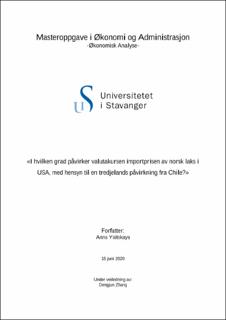| dc.contributor.advisor | Zhang, Dengjun | |
| dc.contributor.author | Yaitskaya, Anna | |
| dc.date.accessioned | 2020-11-11T12:40:53Z | |
| dc.date.available | 2020-11-11T12:40:53Z | |
| dc.date.issued | 2020-06 | |
| dc.identifier.uri | https://hdl.handle.net/11250/2687397 | |
| dc.description | Master's thesis in Economics | en_US |
| dc.description.abstract | The salmon industry has experienced a positive development the last decades, especially in Norway, where almost all salmon production is exported. This study will examine to what extent import prices of Norwegian salmon in the US are affected by a change in the exchange rate from year 2010 to 2018. In the research process, the influence of a third country impact from Chile is taken into consideration. The importance to include a third country effect in studies of the relationship between exchange rate and trade flows is reflected in existing literature and is one of the main prerequisites for the study. To solve the presented problem, a theoretical structural model is derived to include a third country effect. The model is then solved for Exchange Rate Pass-Through (ERPT), which is defined by own-price and cross-price elasticity of demand, supply elasticity and a custom cross-ERPT term based on the relationship between import prices of Chilean salmon and exchange rate between the US and Norway. A linear Almost Ideal Demand System (AIDS) is used to estimate demand elasticities. After adjusting for supply elasticity, ERPT elasticity is estimated and simulated for four scenarios. The first scenario looks at a case without incorporating the influence of a third country, while remaining scenarios considers the third country influence by including assumed values of cross-ERPT.
Empirical results reveal significant differences in the value of estimated ERPT elasticity with and without the influence of a third country. The value of ERPT that did not account for an influence is significantly lower than a typical ERPT on US import prices compared to existing research. The study concludes that a third country influence is crucial to avoid bias estimation of ERPT. The finding is assumed to be of relevance for ERPT research in its entirety, which has implication for subsequent research. The estimation results show a partial ERPT for import prices of Norwegian salmon in the United States with a value varying between 0,288 and 0,623. These results reveal that only parts of the exchange rate variations are affecting the import price. The study finds no evidence of an asymmetric ERPT, suggesting there is no use of market power from the exporter. Findings are consistent with existing literature and can help both the Norwegian salmon industry, and the Norwegian policy makers in making forecasts of price developments in relation to a change in the exchange rate, as well as provide an insight into market power dynamics in the destination market. | en_US |
| dc.language.iso | nob | en_US |
| dc.publisher | University of Stavanger, Norway | en_US |
| dc.relation.ispartofseries | Masteroppgave/UIS-HH/2020; | |
| dc.rights | Navngivelse 4.0 Internasjonal | * |
| dc.rights.uri | http://creativecommons.org/licenses/by/4.0/deed.no | * |
| dc.subject | økonomi | en_US |
| dc.subject | administrasjon | en_US |
| dc.subject | økonomisk analyse | en_US |
| dc.subject | sjømat | en_US |
| dc.title | To what extent does the exchange rate affect the import price of Norwegian salmon in the US, with respect to a third country effect from Chile? | en_US |
| dc.title.alternative | I hvilken grad påvirker valutakursen importprisen av norsk laks i USA, med hensyn til en tredjelands påvirkning fra Chile? | |
| dc.type | Master thesis | en_US |
| dc.subject.nsi | VDP::Social science: 200::Economics: 210::Business: 213 | en_US |

